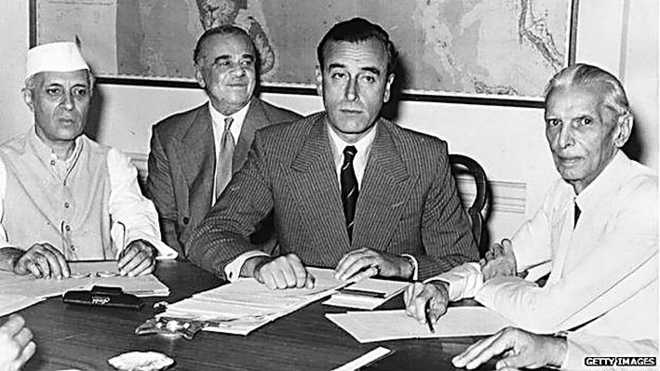
Divide & Rule: Mountbatten announced his plan on June 3, 1947. From left: Jawaharlal Nehru, Lord Ismay, Lord Mountbatten, M.A. Jinnah at the conference on Partition.
RK Kaushik
SEVENTY years ago, on June 3, 1947, at 4 pm the then Governor-General and Viceroy Lord Mountbatten addressed the nation over the radio. He announced his 3rd June Plan, according to which India would be free on August 15, 1947.
Known as the Mountbatten Plan, it was also announced simultaneously in the House of Lords and the House of Commons. M.A. Jinnah on behalf of the All India Muslim League, Jawaharlal Nehru on behalf of the Indian National Congress and Sardar Baldev Singh on behalf of the Sikh community, followed the Viceroy in speaking to the nation over the radio.
Under the Plan, the British would transfer power to two successor authorities, the Congress and the Muslim League. In territorial terms, the dominions of India and Pakistan would remain within the British Commonwealth. Of the 559 princely states in India, 10 states opted for Pakistan and 549 remained in India. The British paramountcy over them would not be transferred to the two dominions and consequently would lapse constitutionally. The third option of the princely states becoming independent and not joining either dominions was kept open for them. This was denied to the British Indian provinces.
The Indian Independence Act of 1947 received King George VI's assent on June 18, 1947. This Act expressly provided for the Partition of Bengal and Punjab and also for the continuation of the Government of India Act, 1935 until the two Dominions framed their own constitutions. Until then, the Governor-General could adapt the GOI Act 1935 to suit the peculiar requirements of his dominion. Lord Listowel became the last Secretary of State. The Congress was the first to accept the Mountbatten Plan by demanding the partition of Punjab and Bengal. The AIML council session was held in camera. It accepted the Mountbatten Plan under protest and authorised Jinnah to take action. This was unacceptable to the Congress leaders, particularly Nehru and Sardar Patel, who wanted a clear-cut acceptance of the Plan before the Congress ratified it. Mountbatten accepted undertakings from both the Congress and the AIML simultaneously. The AIML termed their acceptance a compromise settlement. Stage was set for the creation of Pakistan.
The plan for the transfer of power to India spelt out the procedure in detail. The provincial legislative assemblies of Bengal and Punjab would each be asked to meet in two parts, one representing the Muslim- majority districts and the other the rest of the province. The members of the two parts of each Legislative Assembly sitting separately would be empowered to vote whether or not the province should be partitioned. If a simple majority of either part decided for partition, division would take place. If partition was decided upon, each part of the Legislative Assembly would, on behalf of the areas they represented, decide whether to join the existing Constituent Assembly or a new Constituent Assembly. After this, the Governor-General would appoint a Boundary Commission "to demarcate the boundaries of the two parts of the Punjab on basis of ascertaining the contiguous majority areas of the Muslims and non-Muslims". The Commission would also “be instructed to take into account other factors".
The Plan allowed the existing Constituent Assembly to continue its work and laid down a procedure for those parts which had not accepted it to determine their future. The Punjab and Bengal assemblies were to decide separately whether the two provinces should be divided or stay united and which constituent assembly should demarcate the boundaries of the portioned provinces on the basis of contiguous majority areas of Muslims and non-Muslims and other factors. In case of the partition of Bengal, the Muslim-majority district of Sylhet would decide in a referendum whether it should be merged into East Bengal or form part of Assam and a Boundary Commission would demarcate the boundary. The Sindh assembly at a special meeting would take its decision. Voters of the NWFP assembly would decide in a referendum held under the aegis of the Governor-General and in consultation with the provincial government about one of the two options. Similarly, British Baluchistan would choose one of the options and the Governor-General was authorised to determine the mechanism. An appropriate successor authority would negotiate agreements with the tribes of the North-West Frontier. The policy towards the states was to remain the same as contained in the Cabinet Mission's memorandum (of May 12, 1946).
Listowel, the Secretary of State, suggested to Mountbatten that Lord Cyril Radcliffe be appointed to head the Boundary Commissions for Punjab and Bengal. Radcliffe, educated at Eton and Oxford, became a leading barrister in England. He had worked with Mountbatten before and since he had never been to British India, he was considered unbiased. Both Nehru and Jinnah agreed to the appointment which was formally approved by the Partition Council. At the time of his appointment, Radcliffe was Vice-President of the London Bar Association. Pakistan nominated Justice Din Muhammad and Justice Muhammad Munir as members of Punjab Boundary Commission, while India nominated Justice Mehr Chand Mahajan and Justice Teja Singh. The Boundary Commissions were constituted before the arrival of Radcliffe on July 8, 1947. In retrospect, the June 3 Plan was not a sagacious scheme. Violence during the Partition led to the killing of more than one million people on both sides of the border, the rape of more than 80,000 women and religious conversion of more than 2 lakh people. It was a surgery without anaesthesia.
The writer is an IAS Officer of the Punjab Cadre


























